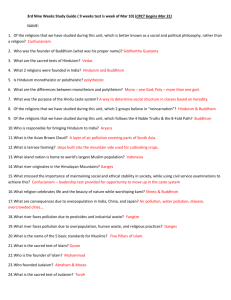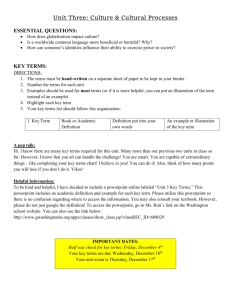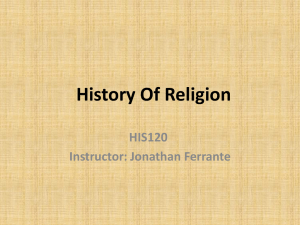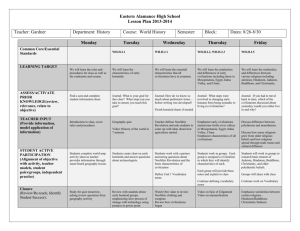World Religions Unit
advertisement
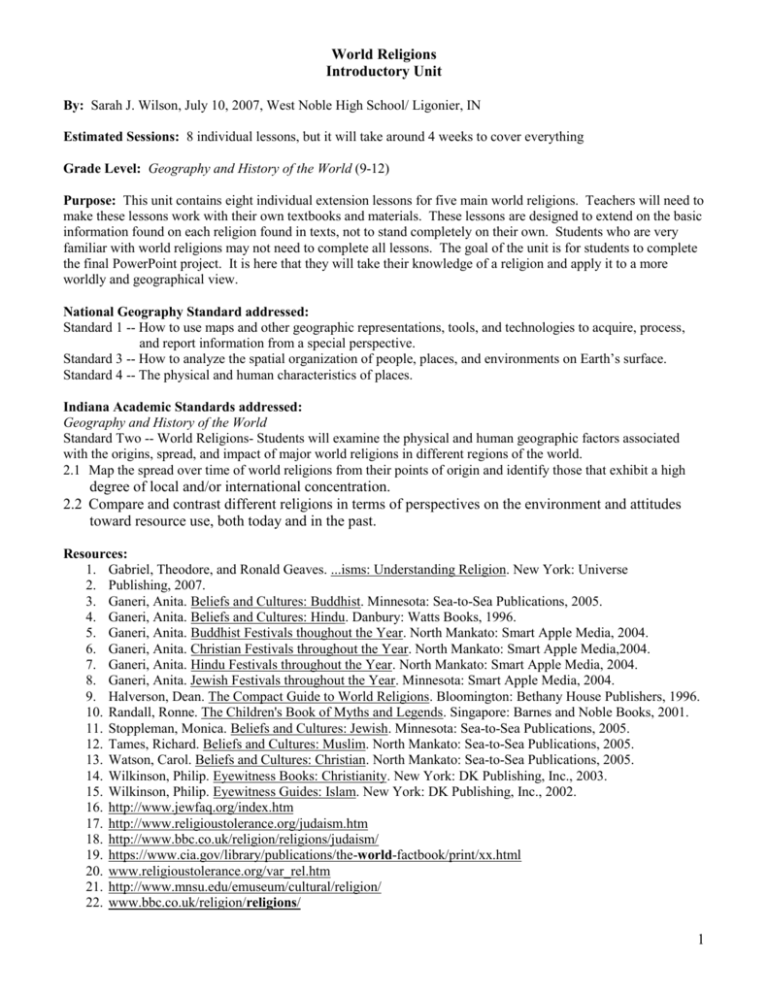
World Religions Introductory Unit By: Sarah J. Wilson, July 10, 2007, West Noble High School/ Ligonier, IN Estimated Sessions: 8 individual lessons, but it will take around 4 weeks to cover everything Grade Level: Geography and History of the World (9-12) Purpose: This unit contains eight individual extension lessons for five main world religions. Teachers will need to make these lessons work with their own textbooks and materials. These lessons are designed to extend on the basic information found on each religion found in texts, not to stand completely on their own. Students who are very familiar with world religions may not need to complete all lessons. The goal of the unit is for students to complete the final PowerPoint project. It is here that they will take their knowledge of a religion and apply it to a more worldly and geographical view. National Geography Standard addressed: Standard 1 -- How to use maps and other geographic representations, tools, and technologies to acquire, process, and report information from a special perspective. Standard 3 -- How to analyze the spatial organization of people, places, and environments on Earth’s surface. Standard 4 -- The physical and human characteristics of places. Indiana Academic Standards addressed: Geography and History of the World Standard Two -- World Religions- Students will examine the physical and human geographic factors associated with the origins, spread, and impact of major world religions in different regions of the world. 2.1 Map the spread over time of world religions from their points of origin and identify those that exhibit a high degree of local and/or international concentration. 2.2 Compare and contrast different religions in terms of perspectives on the environment and attitudes toward resource use, both today and in the past. Resources: 1. Gabriel, Theodore, and Ronald Geaves. ...isms: Understanding Religion. New York: Universe 2. Publishing, 2007. 3. Ganeri, Anita. Beliefs and Cultures: Buddhist. Minnesota: Sea-to-Sea Publications, 2005. 4. Ganeri, Anita. Beliefs and Cultures: Hindu. Danbury: Watts Books, 1996. 5. Ganeri, Anita. Buddhist Festivals thoughout the Year. North Mankato: Smart Apple Media, 2004. 6. Ganeri, Anita. Christian Festivals throughout the Year. North Mankato: Smart Apple Media,2004. 7. Ganeri, Anita. Hindu Festivals throughout the Year. North Mankato: Smart Apple Media, 2004. 8. Ganeri, Anita. Jewish Festivals throughout the Year. Minnesota: Smart Apple Media, 2004. 9. Halverson, Dean. The Compact Guide to World Religions. Bloomington: Bethany House Publishers, 1996. 10. Randall, Ronne. The Children's Book of Myths and Legends. Singapore: Barnes and Noble Books, 2001. 11. Stoppleman, Monica. Beliefs and Cultures: Jewish. Minnesota: Sea-to-Sea Publications, 2005. 12. Tames, Richard. Beliefs and Cultures: Muslim. North Mankato: Sea-to-Sea Publications, 2005. 13. Watson, Carol. Beliefs and Cultures: Christian. North Mankato: Sea-to-Sea Publications, 2005. 14. Wilkinson, Philip. Eyewitness Books: Christianity. New York: DK Publishing, Inc., 2003. 15. Wilkinson, Philip. Eyewitness Guides: Islam. New York: DK Publishing, Inc., 2002. 16. http://www.jewfaq.org/index.htm 17. http://www.religioustolerance.org/judaism.htm 18. http://www.bbc.co.uk/religion/religions/judaism/ 19. https://www.cia.gov/library/publications/the-world-factbook/print/xx.html 20. www.religioustolerance.org/var_rel.htm 21. http://www.mnsu.edu/emuseum/cultural/religion/ 22. www.bbc.co.uk/religion/religions/ 1 Why did Religions Begin and What did they Explain? Materials Needed: Chalkboard Copies of Myths (below) Estimated Time: 50-70 minutes, depending on class discussion. Objective: After completing lesson, students will understand why religions started, what a polytheistic religion is, and be exposed to different ancient myths from various places. Procedure: 1. Begin class by writing the following two sentences on the board. Why and how do religions start? How might geography influence religion? 2. Have students pull out a piece of paper and jot down their ideas and answers. Assure them that you are not looking for one particular answer, that many answers can be good. 3. After students have come up with many answers, ask students to share their ideas. Once ideas are shared, emphasize that religions were started to explain events in the world. Example: A person might ask why it flooded and destroyed a village, an answer might be that the rain god was upset by not praying to him enough and took revenge. Usually if the event was bad or good, it was linked to the people’s actions. 4. Once you have finished discussing why and how religions started, explain to the class that you have an example from Mesopotamia and Egypt for how geography can play a role in religion. Begin the comparison by looking on a map where both Egypt and Mesopotamian civilizations are. Drawing on pervious knowledge, ask students about the rivers that are in both civilizations. Have them draw a line down the back of their piece of paper and have them describe them. (You will want to draw a line down the middle of the board as well.) You will want to emphasize that the Tigris and Euphrates were fast moving and rough in places and that they flooded very quickly and unpredictably. The Nile was relatively easy to navigate and flooding was very predictable. 5. After looking at how the rivers were different, ask they class: How might these rivers shape these two civilizations’ religions. Have students write their ideas on their divided papers. Once student are done, have them share their thoughts. Finish up by reaffirming that Mesopotamian gods were seen as more changeable, vindictive and cruel, while Egyptians gods were more calm, constant and dependable. 6. Next refer to the vocabulary word of polytheism and briefly explain that early ancient civilizations believed in many gods. 7. Students now will look at some early creation myths from various ancient civilizations. You will need to divide the class up into small groups depending on class size. Groups of 3 will work the best. More than one group will have the same myth. Pass out a myth to each group. Have each group read the myth and then answer the following questions. a. Where is this myth from? (Find its location on a map) b. What is it explaining? c. Who are the characters in your myth? d. Draw a quick summary of your myth on a piece of notebook paper. 8. After the groups are done, have each group briefly summarize their myth, share their answers from questions one and two, and locate it on a map. Once everyone is done sharing, have the class look for common themes and if location could have affected each myth. (See Myths in following pages.) Myths came from: Randall, Ronne. The Children's Book of Myths and Legends. Singapore: Barnes and Noble Books, 2001. Assessment: To end, have students do the following questions for an exit slip on the bottom of their notes that they began class with. 1. Which myth did you find most interesting? Why? 2. What was it trying to explain? 3. What might you try to explain through a myth? 2 Judaism: Beliefs and Cultures Jigsaw Project Materials Needed: Computers and Internet Access Library Books on Judaism and the Hebrews Poster Board or butcher paper Markers/glue/scissors Estimated Time: (2 class periods.) 50 minute class period for research and a 50 minute class period for finishing touches and presentations. Objective: After completing this lesson, students will understand some Jewish beliefs, culture, and festivals. Procedures: Day One Divide the class up into eight groups. Each group will be given a Judaism topic that they will need to research and make an informational poster on. Each group will also need to make up five quiz questions that they must give to you at the end of the first day. Make a 16 question quiz, two from each group, for the end of day two. Topics 1. 2. 3. 4. 5. 6. 7. 8. Who are the Jews? (Who are they, where do they live, and what do they believe?) The Torah (What is it and what is in it?) The Temple (What is it and what is its significance?) The Synagogue (What is it, is there one in your town? How is it designed? Who are the active people in it? What is done there?) The Jewish way of life (Duties, food, Shabbat) Rites of Passage (Brit Milah, Bar and Bat Mitzvahs, Marriage, Death and morning) The Jewish Year (Rosh Hashanah, Yom Kippur, Sukkot, Simchat Torah, Chanukah, Purim, Pesach) Persecution (Diaspora, general persecution, Holocaust, Israel) Resource Ideas: Monica, Stoppleman. Beliefs and Cultures: Jewish. Minnesota: Sea-to-Sea Publications, 2005. Anita, Ganeri. Jewish Festivals throughout the Year. Minnesota: Smart Apple Media, 2004. http://www.jewfaq.org/index.htm http://www.religioustolerance.org/judaism.htm http://www.bbc.co.uk/religion/religions/judaism/ Day Two Begin class by allowing students to have about 5 minutes to put the finishing touches on their posters and to catch up for their presentations. Begin presentations. Each should be around 3 minutes long. After each presentation give a bit of time for questions. At the end of all presentations, answer any final questions. You may add any additional information as well. Assessment: Give student the quiz from their presentations. (You may allow them to use notes if they took some during the presentations.) 3 Hinduism: Class vs. Caste Systems- Understanding the Difference Materials Needed: Chalkboard Estimated Time: 50 minute class period Objective: Upon completion of this activity, students will understand how the Hindu caste system is organized and how it is different from a class system. Prior Knowledge: Students should be given an introductory section on Hinduism to read prior to this lesson. Procedures: 1. Begin class by asking students what they know about the beginning of Hinduism. Who started this religion? Where did it start? What are their main beliefs? Do people still practice it? Is it monotheistic? Polytheistic? 2. Once you get your students’ general understanding, begin by explaining that Hinduism is ancient living religion, that it means different things to its believers, and that there is no single book that can explain how to be a Hindu. You will also want to explain that Hindus believe in reincarnation until they reach moksha and break free of the cycle of reincarnation. This cycle of life has various castes in it, which a person must live through to reach moksha. On the board you will want to write the various castes in order, 3. 4. 5. 6. 7. 8. Brahmans (Priests) Kshatriyas (Nobles and Soldiers) Vaishyas (Traders) Sundras (Servants) Untouchables- these are people below the caste system. Explain what each group is. Now you will want to explain that a caste system is very different than the class system that they know about in the United States. On the board, make two sections, one entitled class system, one caste system. Under the section of class system have students brainstorm different social classes in the United States. You may get answers, such as: Rich, middle, poor, educated and uneducated, etc. Follow up your list with a discussion on how a person can change classes in the U.S.? Point out that a poor person may get a job that allows them to move into the middle class, or that a rich person could lose his/her job and move to the middle class or lower. Maybe a poorer person might marry someone wealthy, or a person might go to college and improve his/her status. Students will come up with many ideas. Next, compare your class system to the caste system. Point out that people can’t move to different castes because of life situations. If you are born a Sundra, you will be a Sundra until you die. People are also treated differently dependent on their caste. Ask student how that might make things very different in society. Would you want to marry someone below you? How would that affect your own journey to salvation? After comparing the two systems, students will have a better understanding of each system. Be sure to point out the system is limited, but still used today. People in America treat if differently than if you’re living in India. To extend the lesson, you may want to have students research how the caste system is regarded in India today. (Maybe an outside extra credit idea?) To wrap the lesson up, have students write a short response to whether they would want to live in a caste system or class system and why. 4 Buddhism: Buddha’s Story Materials Needed: Art Supplies to make a small book (Paper, colored pencils/markers/ stapler/glue, etc.) Internet Access and/or Library Books Estimated Time: Two 50 minute class periods Objective: Upon completion of this activity, students will understand who is Siddhartha Guatama is, how Buddhism relates to Hinduism, and how Buddhism was established. Prior Knowledge: Students do not need to have any prior knowledge of Buddhism, but they will need prior knowledge and understanding of Hinduism. I recommend studying Buddhism after Hinduism. Procedure: 1. Begin class by asking students what makes a good children’s book. Spend a few minutes talking about this. Then, tell students that they are going to have to opportunity to create their own children’s book. The founder of Buddhism, Siddhartha Gautama has a very interesting story that they are going to write about. They will first need to research what exactly the story is from books or the internet and then create a book about it. Pass out the Create Buddha’s Story handout. Allow students four days before turning in the assignment. (Two days in class, and two outside of class.) *Before passing out this assignment, look for books in your school library, local libraries, and for acceptable internet sites. Resources: 1. I recommend the following book: Ganeri, Anita. Beliefs and Cultures: Buddhist. Minnesota: Sea-to-Sea Publications, 2005. Assessment: When it is time to turn the books in, have students read each others’. See if there are any differences. Are they large or small? 5 Create Budda’s Story! You are to create a short children’s book on the story of Siddhartha Gautama, the founder of Buddhism. Your book will need to cover the following highlights: His connection to Hinduism The four signs (What he saw when he left the palace) Why he left home and travels What he discovered about enlightenment His teachings and travel Your book is to be between 10-20 pages long. You should not have more than 1-2 paragraphs on a page. Don’t forget that Children’s books need pictures. You may illustrate your book, or find pictures to add to your book. Time: You will have 2 days in class to work, and 2 days outside of class to complete your book. 6 Buddhism: Creating a Zen Garden Materials Needed: Shallow pan Sand Plastic fork Small pebbles, stones, leaves, and a very small branch with leaves from outside Small spray bottle with water Estimated Time: 50 minute class period Objective: Students will understand a type of Buddhism called Zen and how Zen gardens can help meditation. Prior Knowledge: Students will need to have already had an introductory lesson on Buddhism. This is an extension activity. Procedure: 1. Begin class by reviewing with students how enlightenment is gained in Buddhism. Make sure that students know that by deep concentration and meditation a person may achieve enlightenment. One group of Japanese Buddhists practice a form of Buddhism called Zen. These Buddhists create a type of garden that helps them meditate. There are symbols in their gardens that create peace and simplicity. Explain that they are going to make their own Zen gardens. 2. You may have student go outside to find materials, or you have them ready for students before hand. First pass out shallow pans. Put enough sand in them to cover the bottom about ½ to ¾ of an inch. This is to represent land. Next have students place a few small pebbles in their sand. These pebbles are to represent rocks. Now they can add rocks which represent mountains. (I would have them guess what each mean.) After adding their rocks and mountains, have students add a few leaves for bushes and their sticks with leaves for trees. Now ask students what they are missing. Hopefully someone will say water. Spray the sand so that it is wet, but does not have water pooling in it. Students can now use their forks to create patterns in their sand to represent water. Have students try different patterns and have them look at them. Are some more peaceful than others? Zen Buddhists believe that the straighter the line, the more peaceful it is. 3. Once students are done, have them dissemble their gardens so that your next class can create their own. 7 Christian Stained Glass Windows Materials Needed: Chalkboard Several copies of books with Bible stories Large pieces of paper Colored pencils/markers/crayons Estimated Time: One 50 minute class period Objective: Upon completion of this activity, students will become familiar with a Bible story through stained glass windows. Prior Knowledge: Students will need an introductory lesson on Christianity. Procedure: 1. Begin class by writing “What makes a person a Christian?” on the board. You can say that Christianity has its roots in Judaism, but something about it makes it a very different religion. Hopefully students will come up with the idea that a Christian is someone who believes in the teachings of Jesus Christ and in the New Testament in The Bible. Once students are clear that there are many denominations of Christians, but that they all believe in the same central idea, tell students that one thing that all Christians have in common is the New Testament in The Bible. 2. In the New Testament, the first five books are referred to as the Gospels. These books tell of the life and teachings of Jesus Christ. You will also find many parables and stories within these books. In the early church, before printing presses, few people knew how to read the Latin that Bibles were written in and did not have personal copies of it. One way to help people learn about Jesus and his works was through visuals. Churches paid for elaborate stained glass windows that featured Bible stories. Even though people might not understand the sermons in Latin or be able to read The Bible, they could learn about their religion through visual pictures in the windows. 3. Show students the following picture on a projector. This window is in Cathedral of Christ the King Cathedral in Johannesburg, South Africa. Ask students what story this window might represent. 4. After looking and discussing the window, have student get into groups of two. In groups students are to look for a bible story that they want to make a window out of. Using books have each group first make a short summary of the story, then create a window that represents the story. Their windows may have one scene or many in them. 8 Islam Information Brochure Materials Needed: Post-It notes Textbooks Internet or books on Islam Paper Markers/Colored Pencils Estimated Time: Two 50 minute class periods Objective: Students will understand some basic fundamental and cultural beliefs of Muslims. Prior Knowledge: Students will need to have basic knowledge of Islam. Procedure: 1. Begin class by passing out two Post-It notes to each student. Have students write what they know about Islam on one Post-It and questions that they might have about Islam on the second. While students are writing, draw a vertical line down your chalkboard. Label one side what you know, and the other questions. Have students put their Post-Its on the board. Once students are all back in their seats, start looking and sharing their responses. You may have many students volunteering answers as well. This is a great time to share some answers to questions, but leave some unanswered for students to discover. 2. Next lead your in class into the following activity. Set up the scenario and give students the following assignment. 3. You have a friend that is a practicing Muslim. Lately at school you have heard rumors going around about your friend’s behaviors. Other students are not familiar with Islam and don’t understand why your friend does not eat pork, why he/she disappears to pray in the afternoon, and why he/she is constantly giving money to charities, etc. You don’t want your friend to be misunderstood. You want to educate your fellow classmates. You have decided to make brochures to put in the library about Islam. In your brochure include and explain: Who Muhammad was The Five Pillars What some common cultural practices of Muslims Places where Muslims live today 4. You need to include pictures in your brochure. Be sure to clearly explain what you have in your brochure. Pass out paper and supplies and help students get started. Adaptations/Extensions: Place brochures in your school library. 9 …Isms Religion PowerPoint Project (Final Assessment) Materials Needed: PowerPoint access Internet and library access Handouts of project description (cut and paste from plan) Estimated Time: Seven 50 minute class periods (5 for creation and 2 for presentations) Objective: Upon completion of the following activity, students will study one religion in depth and will learn about many others through student presentations. Procedure: 1. Give students the following project handout and help them with ideas for religions, resources, and questions. (See following page.) You may want to establish a minimum/maximum number of slides and time limits for the presentation. Some resource ideas are on page two. Assessment Rubric Excellent Questions covered All areas of questions are covered in detail. Factual and Accurate All information is correct and used in appropriate manners. Satisfactory Below Satisfactory All areas of questions are covered, some details are missing. Some areas of questions are mission, lacking details. Clearly Presented Most information is correct with 1-2 minor errors and used in appropriate manners. PowerPoint is organized PowerPoint is organized and easy to read, visuals and easy to read, 1-2 are present, and mistakes present, visuals Grammar rules are are present, and Grammar consistently used rules are consistently correctly. used with few mistakes. Cited Information All sources are cited at the bottom of pages in correct format. All sources are cited at the bottom of pages, few errors. Incorrect information used, major errors, and used in inappropriate manner. PowerPoint has major organization problems, some difficulty reading, many mistakes present, missing many pictures, and many grammar mistakes. Sources are missing, many errors. Presentation Clearly presents information in PowerPoint in a timely and organized manner. All five questions on quiz are relevant to presentation. Presently information in PowerPoint in an organized manner, time is slightly off. Almost all questions on quiz are relevant to presentation. Quiz Information in PowerPoint is presented in an unorganized manner and time is not used well. Quiz missing or questions are not relevant to presentation. 10 …Isms Religion PowerPoint Project Your goal: To create and present a PowerPoint presentation that fully describes a world religion or a branch of a world religion. Your presentation must include: Who started or how your religion began Where did your religion begin and where are its followers today (maps must be included) What are the core beliefs/values/culture of the religion? What must people do to practice this religion? Where do they practice it? (homes, places of worship) Religion officials Famous people of the religion- if applicable Pictures that are of places of worship, people practicing the religion, etc. How does this religion influence the world? (This must be 25% of your project!) You must become an expert on this one religion. Your presentation must be presented to the class and you will need to make a small five question quiz to give the class following your presentation. You may work by yourself or with a partner. You will have 5 days to work in the library/computer lab. *All resources must be cited* No two individuals or groups may have the same religion. 11

